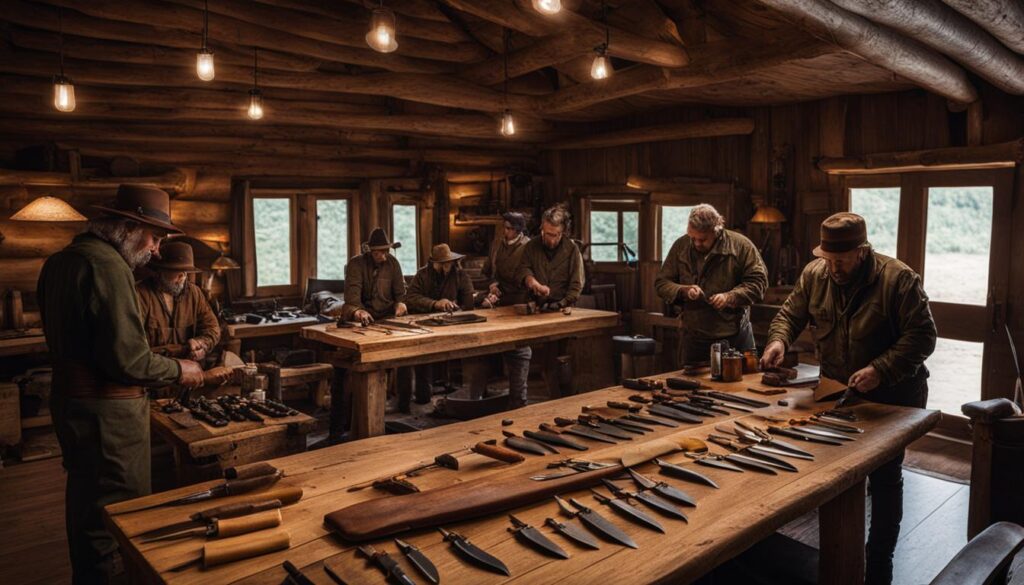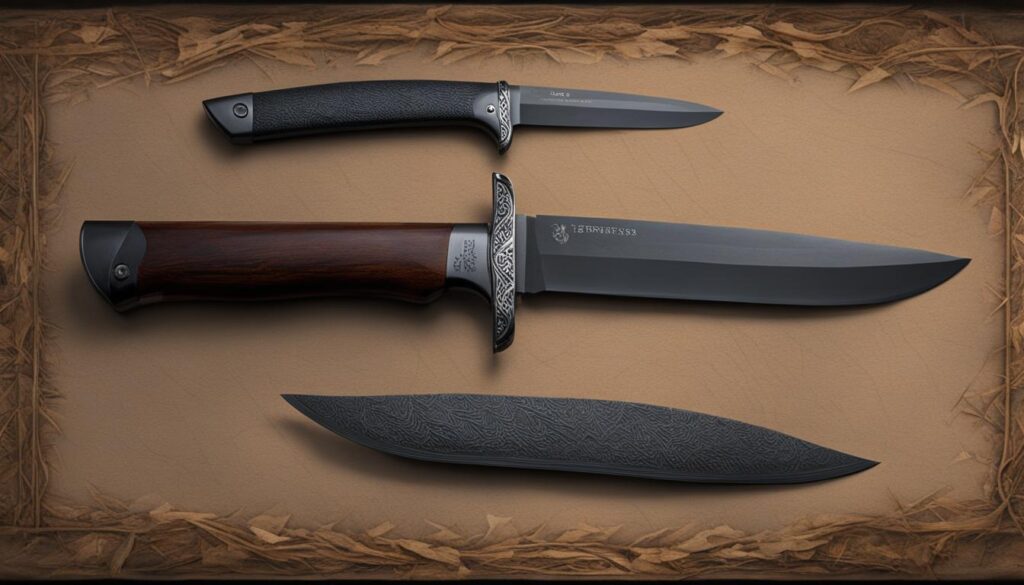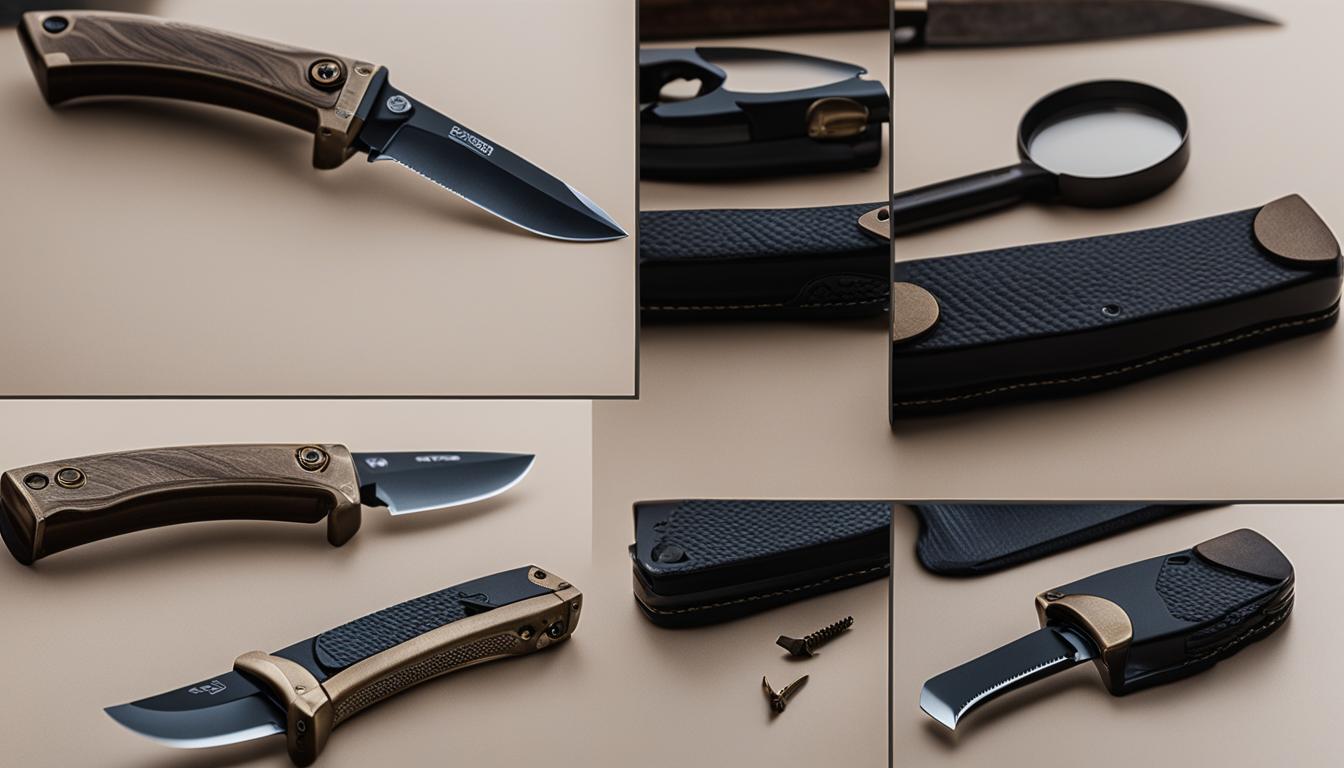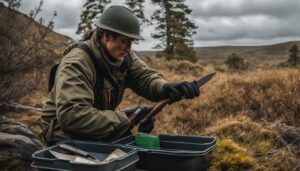When it comes to hunting, having a safe and reliable knife is essential. But with so many options available, how do you choose the right one? In this article, I’ll share with you the top 5 safe knife selection tips that every hunting enthusiast should know. By following these tips, you’ll be able to make an informed decision and ensure that you have a knife that meets your needs and keeps you safe.
Key Takeaways:
- Consider the purpose, size, weight, blade material, handle material, and budget when selecting a hunting knife.
- Different types of knives, such as fixed-blade knives, folding knives, EDC knives, multi-tool knives, and fishing knives, have their own advantages and uses.
- Think about your specific needs and preferences when choosing a hunting knife.
- Proper maintenance and care are crucial for the longevity and optimal performance of your knife.
- Further explore and develop your knife knowledge and skills through workshops, classes, and connecting with the knife community.
Consider Your Specific Needs and Preferences
When choosing a hunting knife, it’s important to consider your specific needs and preferences. After all, a knife that works well for one person may not be the best fit for another. Taking the time to evaluate your requirements will ensure that you select the right knife for your outdoor adventures.
First and foremost, think about the primary tasks you’ll be using the knife for. Are you mainly planning to use it for field dressing game, survival situations, or general outdoor tasks? This will help you determine the blade length and design that will be most suitable for your needs.
Next, consider factors such as the size, weight, handle material, and budget that align with your preferences. Some hunters may prefer a lightweight and compact knife that is easy to carry, while others may prioritize a larger, more robust blade for heavy-duty tasks. Handle materials can vary, from traditional wood to modern synthetic materials, each offering its own advantages in terms of grip and durability. Finally, establish a budget range that is comfortable for you, taking into account the quality and features you desire.
Texan Knives offers a wide range of options to cater to different needs and preferences, ensuring that you can find the perfect knife for your hunting endeavors. By considering your specific needs and preferences, you can choose a hunting knife that is personalized to your requirements, ultimately enhancing your outdoor experience.
Table: Comparison of Hunting Knife Options
| Hunting Knife Type | Advantages | Uses |
|---|---|---|
| Fixed-Blade Knives | Sturdy and reliable | Ideal for demanding outdoor tasks |
| Folding Knives | Compact and portable | Convenient for everyday use |
| EDC Knives | Lightweight and versatile | Suitable for everyday carry |
| Multi-Tool Knives | Combine knife with other essential tools | Perfect for multi-purpose use |
| Fishing Knives | Long, narrow, flexible blade | Ideal for cleaning and filleting fish |
Proper Maintenance and Care for Your Knife
When it comes to your hunting knife, proper maintenance and care are essential to ensure its longevity and optimal performance. By following these knife maintenance and care tips, you can keep your knife in excellent condition for years to come.
1. Clean your knife thoroughly after each use
After using your knife, it’s important to clean it thoroughly to remove any dirt, debris, and moisture. You can use warm soapy water and a soft cloth or sponge to gently clean the blade and handle. Pay special attention to any hard-to-reach areas, such as the pivot area of folding knives, to ensure a thorough clean.
2. Regularly sharpen the blade
Keeping your knife’s blade sharp is crucial for optimal cutting performance. Use a sharpening stone or a knife sharpening tool to maintain the edge of the blade. Follow the manufacturer’s instructions for sharpening angles and techniques.
3. Lubricate the pivot area and locking mechanism
For folding knives, it’s important to lubricate the pivot area and locking mechanism regularly. This helps to ensure smooth opening and closing, as well as proper locking of the blade. Use a lubricant specifically designed for knives to prevent rust and corrosion.
4. Store your knife properly
To prevent rust and corrosion, store your knife in a dry, cool environment. Avoid storing it in a sheath that can retain moisture. Consider using a knife storage case or a knife block to keep your knife protected and easily accessible.
By following these knife maintenance and care tips, you can extend the lifespan of your hunting knife and ensure its reliable performance whenever you need it.
Further Exploration and Skill Development
When it comes to mastering the art of knife handling, there are numerous opportunities for you to expand your skills and knowledge. From workshops and courses to connecting with like-minded individuals, here are some avenues you can explore to take your knife skills to the next level.
Knife Skills Workshops and Classes
Participating in knife skills workshops and classes can provide you with valuable insights and techniques from seasoned experts. These sessions often cover a range of topics, including knife safety, proper handling, and advanced cutting methods. By attending these workshops, you can enhance your proficiency and confidence in using your hunting knife effectively.
Outdoor Survival Courses
While a hunting knife is an essential tool for outdoor adventures, knowing how to use it in survival situations is equally important. Enrolling in outdoor survival courses can equip you with the skills necessary to navigate through the wilderness confidently. These courses typically cover various survival techniques, such as building shelters, lighting fires, and hunting for food. You’ll also learn how to utilize your hunting knife for tasks like preparing food and creating tools for survival.
Connecting with the Knife Community
Joining online forums or social media groups dedicated to knives and outdoor enthusiasts can be a great way to connect with like-minded individuals. Engaging with the knife community allows you to exchange ideas, share experiences, and glean insights from experienced individuals. You can also gain inspiration and discover new knife customization ideas or expand your collection through recommendations and discussions within the community.
Knife Customization
Personalizing your hunting knife through customization can add a unique touch and make it truly yours. From adding engravings to custom handle materials, the possibilities are endless. Exploring different customization options not only allows you to express your individuality but also deepens your appreciation for the craftsmanship of knives. Just make sure to choose customizations that are compatible with the functionality and purpose of your hunting knife.
Expanding Your Knife Collection
If you find yourself growing more passionate about knives, consider expanding your collection. Owning a variety of knives with different features and designs ensures you have the right tool for every job. Whether you’re interested in collecting knives of historical significance or acquiring modern blades with innovative features, building a diverse collection can provide you with a deeper understanding of the craftsmanship and evolution of knives throughout history.

By exploring these avenues, you can further hone your knife skills, gain valuable knowledge, and develop a profound appreciation for the art of knife handling. Remember, the journey of mastering knife skills is a continuous one, and there is always room for growth and improvement.
The History and Evolution of Knives
Knives have a rich and fascinating history that spans thousands of years. From their humble beginnings in prehistoric times to the modern innovations we see today, the evolution of knives showcases the ingenuity and adaptability of human civilization. Understanding the origins and development of knives can deepen our appreciation for these essential tools.
The earliest knives were crafted from stone, with flint being a popular material due to its sharp edges. These primitive knives were used primarily for cutting and piercing, aiding early humans in tasks such as hunting, food preparation, and protection. As metallurgy advanced, knives began to be made from various metals, including bronze and iron. This shift opened up new possibilities, as metal blades were more durable and could be sharpened to a finer edge.
The advent of stainless steel and high-carbon steel in the 20th century marked a significant milestone in knife technology. These materials offered improved corrosion resistance, strength, and edge retention, making them ideal for a wide range of applications. Today, knives come in a myriad of designs and styles, each tailored to specific needs and preferences. From folding knives with intricate locking mechanisms to fixed-blade knives designed for heavy-duty tasks, the evolution of knives continues to meet the demands of modern users.
“The evolution of knives showcases the ingenuity and adaptability of human civilization.”
The Evolution of Knives: Key Milestones
| Time Period | Key Developments |
|---|---|
| Prehistoric Times | Use of stone knives, primarily made from flint |
| Bronze Age | Introduction of metal knives, crafted from bronze |
| Iron Age | Widespread use of iron knives, offering improved durability and sharpness |
| 20th Century | Advancements in steel technology, including stainless steel and high-carbon steel |
The history and evolution of knives not only showcase the advancements in materials and technology but also reflect the cultural and societal needs of the time. Knives have played significant roles in various civilizations and continue to be essential tools in our everyday lives, serving purposes ranging from cooking to self-defense. By understanding the origins and development of knives, we gain a deeper appreciation for these versatile instruments, appreciating their impact on human history and their continued relevance in the present day.


- Knives have a rich history that dates back thousands of years.
- The earliest knives were made from stone, such as flint.
- Metallurgy advancements led to the use of bronze and iron for knife-making.
- The introduction of stainless steel and high-carbon steel in the 20th century revolutionized knife technology.
- Today, knives come in various designs and styles, tailored to specific needs and preferences.
The evolution of knives reflects the progress of human civilization, showcasing our ingenuity and adaptability. This history provides valuable insights into the development of tools and technology throughout the ages.
Conclusion
As a hunting enthusiast, selecting a safe and suitable knife is of utmost importance. By considering factors such as purpose, size, weight, blade material, handle material, and budget, you can ensure you choose the perfect knife for your outdoor adventures.
Maintaining and caring for your knife is essential to keep it in excellent condition. Clean your knife thoroughly after each use to remove dirt and moisture. Regularly sharpen the blade and lubricate folding knives to maintain their performance. Storing your knife in a dry and cool environment will prevent rust and corrosion.
For those looking to enhance their knife skills, there are plenty of options available. Consider attending knife skills workshops or classes to learn advanced techniques and safety practices. Engage with the knife community through online forums and social media groups to connect with fellow enthusiasts and gain valuable insights. You can also explore customization options to personalize your hunting knife and expand your collection over time.
Understanding the rich history and evolution of knives adds depth to your appreciation for these versatile tools. From their early beginnings as stone tools to the modern innovations in metallurgy, knives have played a crucial role throughout human history. Embrace the knowledge of knife history as you embark on your hunting journeys.
FAQ
What factors should I consider when selecting a hunting knife?
When selecting a hunting knife, it’s important to consider the purpose, size and weight, blade material, handle material, and budget.
What are the different types of knives available for hunting?
Different types of knives for hunting include fixed-blade knives, folding knives, EDC knives, multi-tool knives, and fishing knives.
What tasks are fixed-blade knives ideal for?
Fixed-blade knives are sturdy and reliable, making them ideal for demanding outdoor tasks.
What are hunting knives designed for?
Hunting knives are specifically designed for skinning and field dressing games.
What tasks are survival knives suitable for?
Survival knives are versatile and durable, making them suitable for various outdoor tasks.
What are the advantages of folding knives?
Folding knives are compact and portable, making them convenient for everyday use.
What makes EDC knives unique?
EDC knives are lightweight and versatile, making them suitable for everyday carry.
What do multi-tool knives combine with a knife?
Multi-tool knives combine a knife with other essential tools.
What is the purpose of fishing knives?
Fishing knives have a long, narrow, flexible blade for cleaning and filleting fish.
How should I maintain and care for my hunting knife?
After each use, clean your knife thoroughly, regularly sharpen the blade, lubricate the pivot and locking mechanism of folding knives, and store the knife in a dry, cool environment.
How can I further explore and develop my knife knowledge and skills?
Consider attending knife skills workshops or classes, enrolling in outdoor survival courses, connecting with the knife community, exploring customization options, and expanding your collection of knives.
What is the history and evolution of knives?
Knives have been essential tools for thousands of years, evolving from stone to materials like stainless steel and high-carbon steel.





